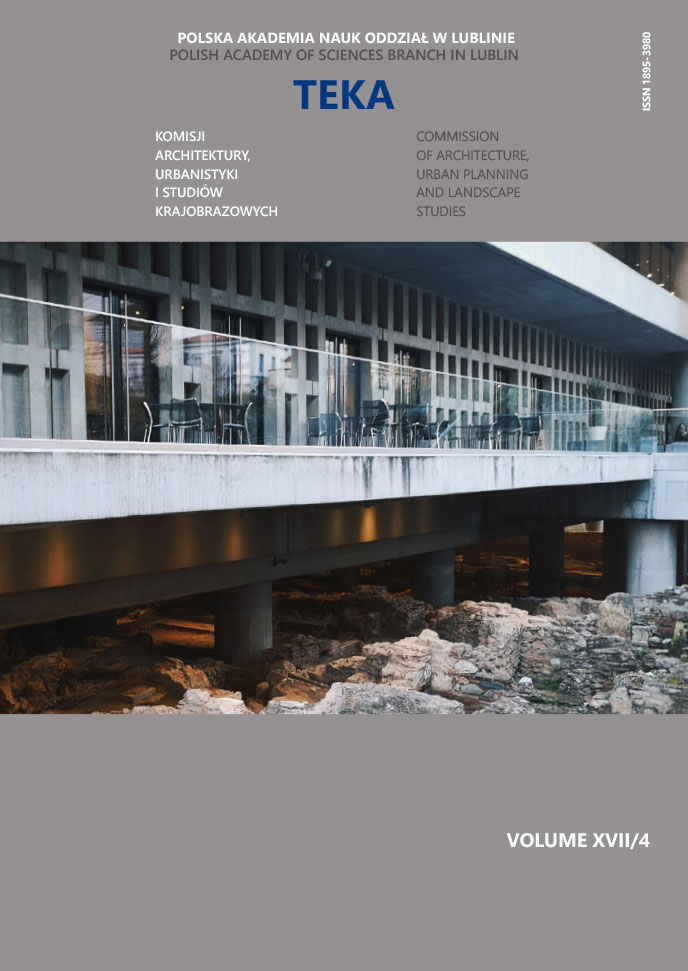Tourist accommodation of castles and palaces located within the Lower Silesian Voivodeship
Article Sidebar
Open full text
Issue Vol. 17 No. 4 (2021)
-
Tourist accommodation of castles and palaces located within the Lower Silesian Voivodeship
Agnieszka Adamska7-18
-
Painting in the exhibition space, interactions
Joanna Stefańska19-24
-
Fort Bema (P-Parysów) in Warsaw – adaptation to the city recreation function
Piotr Gleń, Cezary Głuszek25-32
-
Phenomenon of the Work of Architect and Visual Artist Włodzimierz Ściegienny
Emilia Malec-Zięba33-49
-
Architectural education according to the didactic thought of Professor Bolesław Szmidt
Wojciech Jabłoński50-56
-
Evaluation of remote learning at technical universities during a pandemic – the perspectives for the future
Dariusz Gaweł57-63
-
Budownictwo z opoki wapnistej na terenie Lubelszczyzny
Katarzyna Drobek, Maciej Trochonowicz64-73
-
Large shopping centres in Poznań as a source of rainwater recovery and irrigation of urban green areas
Paweł Piotr Szumigała, Piotr Urbański, Karolina Olenia Szumigała74-81
-
Quality assessment of past thermal upgrading projects and an attempt to classify characteristic problems using two-level thermography
Anna Ostańska82-91
-
Definiowanie barier w przestrzeniach publicznych
Katarzyna Szmygin99-109
-
The truth of contemporary architecture and aesthetics categories
Andrzej Tokajuk110-116
Archives
-
Vol. 19 No. 2
2023-12-29 11
-
Vol. 19 No. 1
2023-12-19 13
-
Vol. 18 No. 4
2022-12-30 5
-
Vol. 18 No. 3
2022-12-27 5
-
Vol. 18 No. 2
2022-12-27 5
-
Vol. 18 No. 1
2022-12-27 4
-
Vol. 17 No. 4
2021-12-30 11
-
Vol. 17 No. 3
2021-12-30 9
-
Vol. 17 No. 2
2021-12-30 8
-
Vol. 17 No. 1
2021-12-30 8
-
Vol. 16 No. 4
2020-12-30 11
-
Vol. 16 No. 3
2020-09-30 10
-
Vol. 16 No. 2
2020-06-30 11
-
Vol. 16 No. 1
2020-03-31 10
-
Vol. 15 No. 4
2019-12-30 6
-
Vol. 15 No. 3
2019-10-31 9
-
Vol. 15 No. 2
2019-06-28 12
-
Vol. 15 No. 1
2019-03-29 13
Main Article Content
DOI
Authors
Abstract
Properly prepared accommodation base, apart from specific tourist values, world situation and advanced infrastructure, has a great impact on contemporary tourism development. The paper focuses on main features of Lower Silesian tourist accommodation establishments founded in entered into the heritage register castles and palaces. As observed, tourist base is subject to dynamic changes and stands out with susceptibility to various factors, hence new types of lodgings with specific characteristics appear. One of the tendencies is growing interest in historical landmarks overnight stays. Simultaneously, the voivodeship, as the only one in Poland, despite ongoing pandemic, recorded increase in the number of accommodation enterprises. Therefore, it seems that there is a great need for further research aimed at understanding the potential and trends in such complexes creation.
Keywords:
References
Act of August 29, 1997 on hotel services and the services of tour leaders and tourist guides, (Ustawa z dn. 29 sierpnia 1997 r. o usługach hotelarskich oraz usługach pilotów wycieczek i przewodników turystycznych).
Adamska A., Osieczna – development possibilities as a health and SPA resort, Teka Komisji Architektury, Urbanistyki i Studiów Krajobrazowych, 16(1), 2020, p. 58−70, https://doi.org/10.35784/teka.2370. DOI: https://doi.org/10.35784/teka.2370
Alejziak W., Turystyka w obliczu wyzwań XXI wieku (Tourism in the face of the 21st century challenges – self-translation), Kraków, Albis 1999.
Benner M., The decline of tourist destinations: An evolutionary perspective on overtourism, Sustainability, 12 (9), 3653, 2020, https://doi.org/10.3390/su12093653. DOI: https://doi.org/10.3390/su12093653
Cierpiał-Wolan M., GUS. Tourism in 2020. Statistical analyses (GUS. Turystyka w 2020 r., analizy statystyczne), Warszawa 2021, https://stat.gov.pl/obszary-tematyczne/kultura-turystyka-sport.
Cudny W., Rouba R., Hotelarstwo jako sposób na rewitalizację zabytkowych obiektów militarnych pochodzących z XIX i XX wieku (Hospitality as a way to revitalize historic military complexes from the 19th and 20th centuries – self-translation), „Ochrona Zabytków”, 3−4, 2021.
Gaworecki W., Turystyka (The Tourism – self-translation), Polskie Wydawnictwo Ekonomiczne, Warszawa 2003.
Gonda-Soroczyńska E., Soroczyńska A.M., Możliwości i bariery w przekształceniach funkcjonalno-przestrzennych wsi Piotrówek – studium przypadku (Possibilities and barriers in functional and spatial transformations of the Piotrówek village – case study – self-translation), „Prace Naukowe Uniwersytetu Ekonomicznego we Wrocławiu”, 339, 2014. DOI: https://doi.org/10.15611/pn.2014.339.02
Grabiszewski M., Adaptacja budowli zabytkowych na cele hotelowe (Adaptation of historic buildings for hotel purposes – self-translation) in: Adaptacja obiektów zabytkowych do współczesnych funkcji użytkowych (Adaptation of historic buildings to modern service functions – self-translation), ed. Szmygin B., Warszawa, Lublin Scientific Society (self-translation) ICOMOS Lublin University of Technology 2009.
Leśniewska-Napierała K., Napierała T., Funkcja hotelarska w rewitalizacji obszarów wiejskich studium przypadków w województwie pomorskim. Turyzm/Tourism, 27 (2), 2017, p. 66−76, http://dx.doi.org/10.18778/0867-5856.27.2.06 DOI: https://doi.org/10.18778/0867-5856.27.2.06
Łuczyński R.M., Zamki i pałace Dolnego Śląska (Castles and palaces of Lower Silesia – self-translation), Wrocław, Oficyna Wydawnicza PWr 2008.
Regulation of the Ministry of Economy and Labour of August 19, 2004 on hotel establishments and other buildings where hotel services are provided, (Rozporządzenie Ministra Gospodarki i Pracy z dn. 19 sierpnia 2004 r. w sprawie obiektów hotelarskich i innych obiektów, w których są świadczone usługi hotelarskie). DOI: https://doi.org/10.1049/ee.2004.0007
Rouba P., Hotele w obiektach zabytkowych (Hotels in historic buildings – self-translation) in: Ochrona Zabytków (Protection of Monuments – self-translation), nr 1/2, 2004, p. 143−164.
Stępień B., Mruk H., Różnice w postrzeganiu luksusu w Polsce i na świecie, 2017, https://www.ican.pl/b/roznice-w-postrzeganiu-luksusu-w-polsce-i-na-swiecie/P113QvNyZ.
Tiwari P., Chowdhary N., Has COVID-19 brought a temporary halt to overtourism? Turyzm/Tourism, 31 (1), 2021, p. 89−93, https://doi.org/10.18778/0867-5856.31.1.20. DOI: https://doi.org/10.18778/0867-5856.31.1.20
Turkowski M., Marketing usług hotelarskich (Marketing of hotel services – self-translation), Warsaw, Polish Economic Publishing (self-translation) 2010.
Walas B., Marketingowa strategia Polski w sektorze turystyki na lata 2012−2020, 2008. (Marketing strategy of polish tourism sector for the period 2012−2020 – self-translation) https://www.pot.gov.pl/pl/o-pot/plany-i-sprawozdania-pot/marketingowa-strategia-polski-w-sektorze-turystyki-na-lata-2012-2020-2.
Article Details
Abstract views: 354
License

This work is licensed under a Creative Commons Attribution-ShareAlike 4.0 International License.


